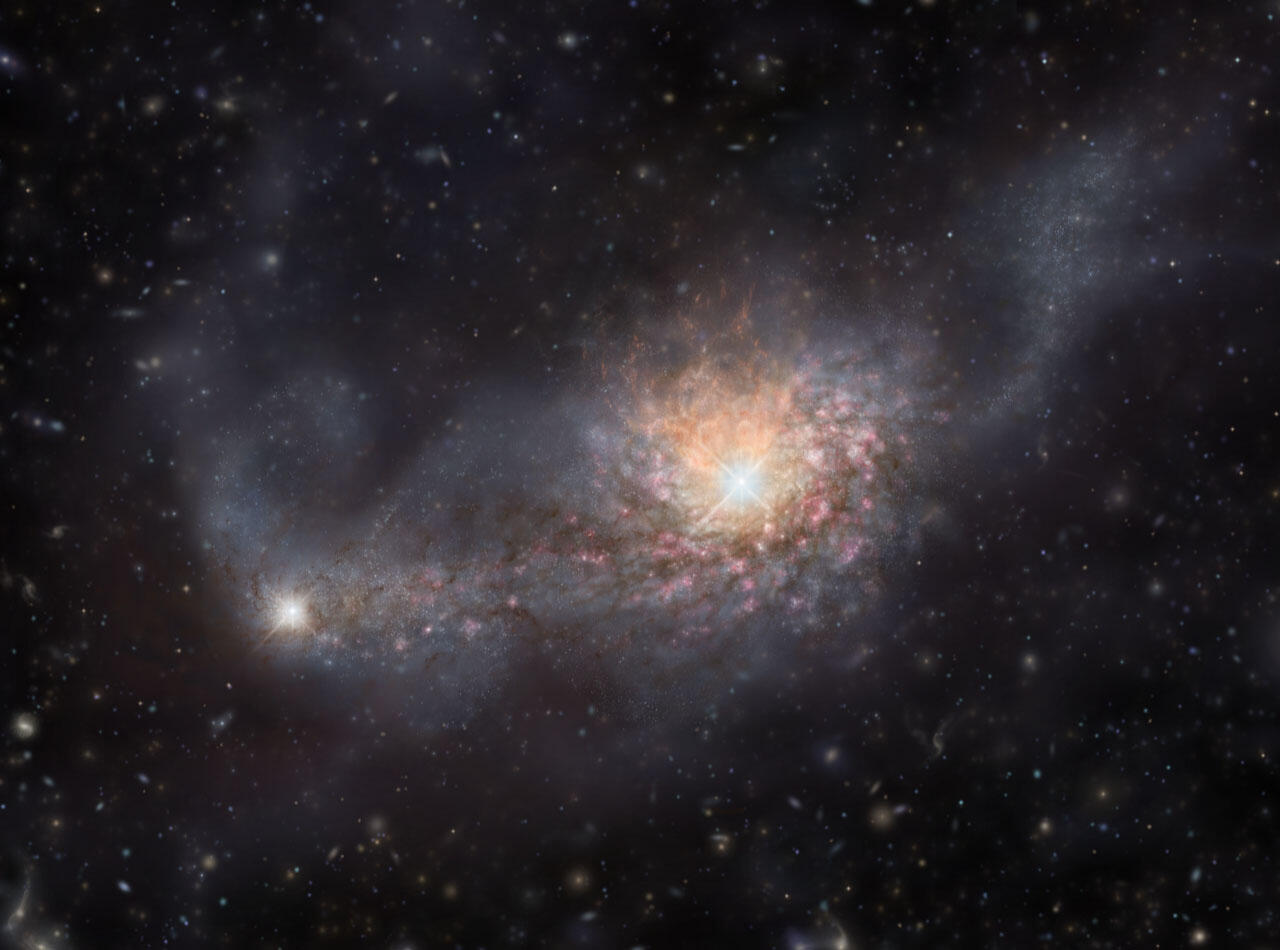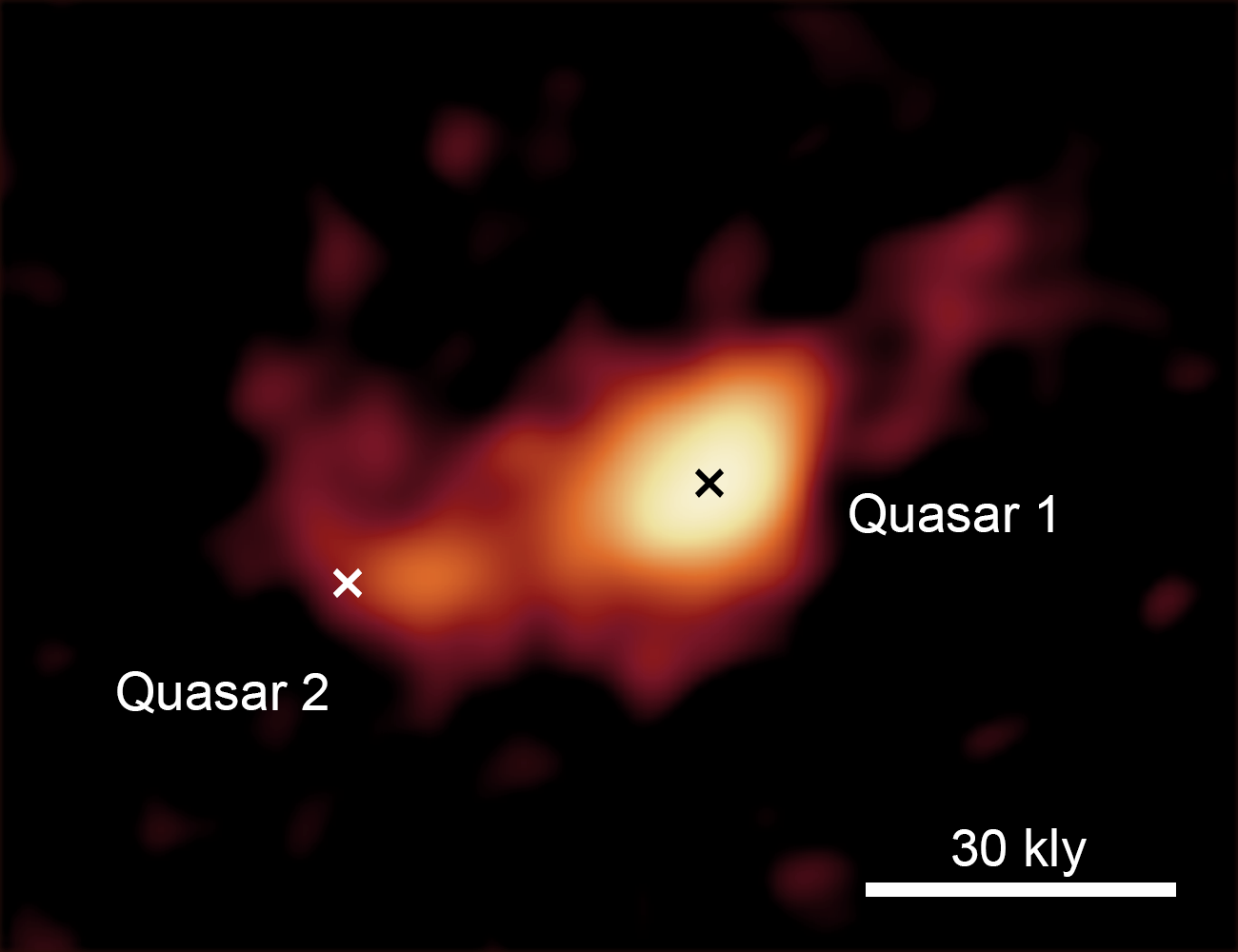Detailed observations using the ALMA radio telescope of a pair of quasars discovered by the Subaru Telescope have revealed that these objects are ancestors of high-luminosity quasars, the brightest type of celestial bodies in the early Universe. This discovery provides significant insights into the evolution of galaxies and black holes in the early Universe.

Figure 1: Artist's impression of the interacting galaxies observed in this research. The gravitational interactions during the merger trigger both starburst and quasar activity. (Credit: ALMA (ESO/NAOJ/NRAO), T. Izumi et al.)
Observations have revealed that even in the early Universe high-luminosity quasars, supermassive black holes with masses exceeding a billion times that of the Sun, were already present within galaxies. It is also known that quasar host galaxies often undergo intense star formation. The most accepted theory suggests that the mergers of gas-rich galaxies trigger and sustain the rapid growth of both the central supermassive black holes and starburst activity. However, detecting these precursor galaxies and black holes before they become bright quasars has been challenging due to their faintness, hindering our understanding of galaxy/black hole formation in the early Universe.
To overcome this challenge, a research team led by Associate Professor Yoshiki Matsuoka of Ehime University analyzed large-scale survey data taken with the Subaru Telescope's Hyper Suprime-Cam, which boasts an extremely wide field of view. This survey, utilizing the Subaru Telescope's high light-gathering power, is significantly more sensitive than other large-scale surveys, enabling the detection of fainter objects. As a result, the team discovered a system where two very faint quasars (about 10 to 100 times fainter than high-luminosity quasars of the same era) were found side by side (Subaru Telescope June 17, 2024 Science Results). Located approximately 12.8 billion light-years away, corresponding to the "Cosmic Dawn" era when the Universe was only 900 million years old, this is the most distant record of such "pair quasars." Due to their faintness, these objects are thought to be in the pre-merger stage before the rapid growth of the supermassive black holes.
As a next step, a research team led by Associate Professor Takuma Izumi of the National Astronomical Observatory of Japan conducted observations of the host galaxies of these pair quasars using the ALMA radio telescope. The results were astonishing.
"When we first observed the interaction between these two galaxies, it was like watching a dance, with the black holes at their centers having started their growth. It was truly beautiful," says Dr. Izumi. The map of interstellar gas showed that the galaxies are linked by a "bridge" of gas and dust. This indicates that the two galaxies are in fact merging.

Figure 2: The interacting galaxies observed by the ALMA radio telescope at the Cosmic Dawn. This image shows the distribution of ionized carbon gas, which reflects the overall distribution and motion of interstellar matter. It is clearly visible that the two galaxies are interacting, and are connected by a structure between them. The two crosses in the image indicate the positions of the low-luminosity quasars discovered by the Subaru Telescope.
The team also found that the two galaxies are very rich in gas, suggesting that post-merger explosive star formation and fueling of the supermassive black holes should be easily triggered and sustained. These findings represent a significant achievement in identifying the ancestors of high-luminosity quasars—the brightest celestial objects in the early Universe—and starburst galaxies.
"With the combined power of the Subaru Telescope and ALMA, we have begun to unveil the nature of the central engines (supermassive blackholes), as well as the gas in the host galaxies. However, the properties of the stars in the host galaxies remain unknown. By using the James Webb Space Telescope, we will be able to learn about the stellar properties of these objects. As these are the long-sought ancestors of high-luminosity quasars, which should serve as a precious cosmic laboratory, I hope to deepen our understanding of their nature and evolution through various observations in the future," says Dr. Izumi.
These results appeared as Izumi et al. "Merging Gas-rich Galaxies that Harbor Low-luminosity Twin Quasars at z = 6.05: A Promising Progenitor of the Most Luminous Quasars" in The Astrophysical Journal on August 29, 2024.


